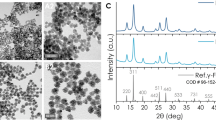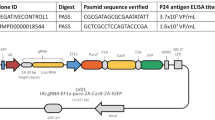Abstract
Heat-induced therapeutic gene expression is highly desired for gene therapy to minimize side effects. Furthermore, if the gene expression is triggered by heat stress, combined therapeutic effects of hyperthermia and gene therapy may be possible. We combined TNF-α gene therapy driven by the stress-inducible promoter, gadd 153, with hyperthermia using magnetite cationic liposomes (MCLs). In nude mice, MCLs induced cell death throughout much of the tumor area on heating under an alternating magnetic field. This heat stress also resulted in a 3-fold increase in TNF-α gene expression driven by the gadd 153 promoter as compared with that of nonheated tumor. TNF-α gene expression was also observed in the peripheral area where the hyperthermic effect was not enough to cause cell death. The combined treatment strongly arrested tumor growth in nude mice over a 30-day period, suggesting potential for cancer treatment. Cancer Gene Therapy (2001) 8, 649–654.
This is a preview of subscription content, access via your institution
Access options
Subscribe to this journal
Receive 12 print issues and online access
$259.00 per year
only $21.58 per issue
Buy this article
- Purchase on Springer Link
- Instant access to full article PDF
Prices may be subject to local taxes which are calculated during checkout
Similar content being viewed by others
References
Gerner EW, Hersh EM, Pennington M, et al . Heat-inducible vectors for use in gene therapy Int J Hyperthermia 2000 16: 171–181
Walther W, Stein U, Fichtner I, et al . mdr1 promoter-driven tumor necrosis factor-α expression for a chemotherapy-controllable combined in vivo gene therapy and chemotherapy of tumors Cancer Gene Ther 2000 7: 893–900
Manome Y, Kunieda T, Wen PK, et al . Transgene expression in malignant glioma using a replication-defective adenoviral vector containing the EGR-1 promoter: activation by ionizing radiation or uptake of radioactive iododeoxyuridine Hum Gene Ther 1998 9: 1409–1417
Bellomo G, Perotti M, Taddei F, et al . Tumor necrosis factor α induces apoptosis in mammary adenocarcinoma cells by an increase in intranuclear free Ca2+ concentration and DNA fragmentation Cancer Res 1992 52: 1342–1346
Palladino MA, Shalaby MR, Kramer SM, et al . Characterization of the antitumor activities of human tumor necrosis factor-α and the comparison with other cytokines: induction of tumor specific immunity J Immunol 1987 138: 4023–4032
Spriggs DR, Yates SW . Cancer chemotherapy: experience with TNF administration in humans In: Beutler B, ed. Tumor Necrosis Factors: the Molecules and Their Emerging Roles in Medicine New York: Raven Press 1992 383–406
Kobayashi T . Hyperthermia for brain tumors Jpn J Hyperthermic Oncol 1993 9: 245–249
Raaphorst G, Yang H, Wilkins D, et al . Cisplatin, hyperthermia and radiation treatment in human cisplatin-sensitive and resistant glioma cell lines Int J Hyperthermia 1996 12: 801–812
Montes H, Hynynen K . A system for the simultaneous delivery of intraoperative radiation and ultrasound hyperthermia Int J Hyperthermia 1995 11: 109–119
Watanabe N, Niitsu Y, Umeno H, et al . Synergistic cytotoxic and antitumor effects of recombinant human tumor necrosis factor and hyperthermia Cancer Res 1988 48: 650–653
Shinkai M, Matsui M, Kobayashi T . Heat properties of magnetoliposomes for local hyperthermia Jpn J Hyperthermic Oncol 1994 10: 168–177
Shinkai M, Yanase M, Honda H, et al . Intracellular hyperthermia for cancer using magnetite cationic liposomes: in vitro study Jpn J Cancer Res 1996 87: 1179–1183
Yanase M, Shinkai M, Honda H, et al . Intracellular hyperthermia for cancer using magnetite cationic liposomes: ex vivo study Jpn J Cancer Res 1997 88: 630–632
Yanase M, Shinkai M, Honda H, et al . Intracellular hyperthermia for cancer using magnetite cationic liposomes: an in vivo study Jpn J Cancer Res 1998 89: 463–469
Luethy JD, Fargnoli J, Park JS, et al . Isolation and characterization of the hamster gadd153 gene J Biol Chem 1990;2 65: 16521–16526
Luethy JD, Holbrook NK . Activation of the gadd153 promoter by genotoxic agents: a rapid and specific response to DNA damage Cancer Res 1992 52: 5–10
Delmastro DA, Li J, Vaisman A, et al . DNA damage inducible-gene expression following platinum treatment in human ovarian carcinoma cell lines Cancer Chemother Pharmacol 1997 39: 245–253
Ropp M, Courgeon AM, Calvayrac R, et al . The possible role of the superoxide ion in the induction of heat-shock and specific proteins in aerobic Drosophila cells during return to normoxia after a period of anaerobiosis Can J Biochem Cell Biol 1983 61: 456–461
Ito A, Shinkai M, Bouhon IA, et al . Induction of TNF-α gene expression by heat inducible promoter gadd 153 Jpn J Hyperthermic Oncol 2000 16: 91–98
Ito A, Shinkai M, Bouhon IA, et al . Bystander-killing effect and cyclic induction of TNF-α gene under heat inducible promoter gadd 153 J Biosci Bioeng 2000 90: 437–441
Yoshida J, Mizuno M, Yagi K . Secretion of human β-interferon into the cystic fluid of glioma transfected with the interferon gene J Clin Biochem Nutr 1991 11: 123–128
Montgomery D . Design and Analysis of Experiments 3rd edn New York: John Wiley and Sons 1991
Bramson JL, Hitt M, Gauldie J, et al . Pre-existing immunity to adenovirus does not prevent tumor regression following intratumoral administration of a vector expressing IL-12 but inhibits virus dissemination Gene Ther 1997 4: 1069–1076
Zhang R, Straus FH, DeGroot LJ . Effective genetic therapy of established medullary thyroid carcinomas with murine interleukin-2: dissemination and cytotoxicity studies in a rat tumor model Endocrinology 1999 140: 2152–2158
Mizuno M, Yoshida J, Sugita K, et al . Growth inhibition of glioma cells transfected with the human β-interferon gene by liposomes coupled with a monoclonal antibody Cancer Res 1990 50: 7826–7829
Le B, Shinkai M, Kitade T, et al . Preparation of tumor-specific magnetoliposomes and their application for hyperthermia J Chem Eng Jpn 2000 33: 821–826
Acknowledgements
We are grateful to Nikki Holbrook (National Institute on Aging, Baltimore, MD) for providing the JymCAT0 plasmid including the gadd 153 promoter and Hirohumi Hamada (Cancer Chemotherapy Center, Japanese Foundation for Cancer Research) for providing the plasmid SKhTNF-α including the h TNF-α gene.
Author information
Authors and Affiliations
Corresponding author
Additional information
This study was partially funded by a Grant-in-Aid for Scientific Research on Priority Areas (Nos. 10145104 and 11227202) and a Grant-in-Aid for JSPS Fellows (No. 12004238) from the Ministry of Education, Science, Sports and Culture of Japan.
Rights and permissions
About this article
Cite this article
Ito, A., Shinkai, M., Honda, H. et al. Heat-inducible TNF-α gene therapy combined with hyperthermia using magnetic nanoparticles as a novel tumor-targeted therapy. Cancer Gene Ther 8, 649–654 (2001). https://doi.org/10.1038/sj.cgt.7700357
Received:
Published:
Issue Date:
DOI: https://doi.org/10.1038/sj.cgt.7700357
Keywords
This article is cited by
-
Recording 25 years of progress in Cancer Gene Therapy
Cancer Gene Therapy (2019)
-
Liver transcriptome response to hyperthermic stress in three distinct chicken lines
BMC Genomics (2016)



